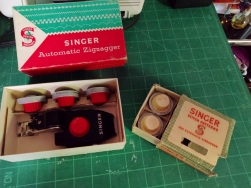Vintage: new is not always better!
Sewing has been part of my life since I was very small (that is me on the left playing with my grandmother’s sewing machine (1969). The important ladies in my life knew how to stitch and passed their love of stitching and knowledge onto me. My Mother knew how to fashion home decor items and clothing for kids and adults. My Grandmother spent many years working in Silk-o-Lina, a ladies wear, sewing goods and alterations store. She was well trained and practised with a sewing machine and thread. My favourite aunt knew how to turn fabric into dolls and toys that I still cherish today. I am indebted to these talented ladies for sharing their knowledge and their patience as I learned the skills of the trade. These skills have served me well for over 40 years (and counting) and I am still learning new and exciting techniques.
Stitching helps…
- me make my home comfortable
- helps me keep my children warm and clothed
- me capture and make memories
- helps me generate income
- me be patient and encourages dedication
- me to pay close attention to detail
- me see that rules provide structure, but must be broken often
- me maintain personal peace and balance
When things get crazy and the chaos of life creeps in, I pull out yarn and needles or dig into my fabric stash for something that inspires me to stitch up a skirt, a pillow, or a nifty new bag.
Stitching helps me navigate life.
New is not always better!
Only once in my stitching career have I owned a brand new machine. It was an entry level Pfaff that served me well for ten years. Sadly, the transmission blew and it was quickly shipped off to the sewing machine graveyard. My Mom, an expert bargain hunter, found an old Baycrest branded Riccar (circa early 1960s) sewing machine to replace the Pfaff. Little did I know that this solution would lead to a lifelong love of vintage sewing machines.
Today, I’d be hard pressed to spend thousands dollars on a modern machine with all sorts of bells and whistles. The offerings are shiny and new, but complicated and difficult to work with. They are built with plastic and thin metal-like substances. They are frustrating to troubleshoot when things go wrong. They are light and prone to jumping when stitching at high speeds. They do not like bulky layers and complain by skipping stitches and breaking needles.
Modern machines, in my humble opinion, are soulless tools that lack character and soul.
Modern machines are not of the same quality as the machines created in the early 1900s through to the 1970s or so. They might have loads of features and options that allow the stitcher to add beauty and interest to their work, but we don’t really need all those complicated computerised features. All we really need to create quality items is a machine that stitches straight and true.
Enter vintage!
Vintage machines have everything we need. Their stitching remains straight and true and has withstood the test of time. Manufacturer’s concentrated on creating quality tools that brought both function and beauty to many homes throughout the world. Many of them have outlasted generations of stitchers and continue to help us create beautiful items that help us add beauty to our homes, keep our families warm and comforted, and enable us to produce income.
Vintage sewing machines are like time portals to our past. They help us connect to previous generations of stitchers. They keep us grounded to our stitching roots.
Vintage sewing machines have the ability to transport us into the hearts and minds of the stitchers of yesterday. Each one has a story to tell.
This is why I love vintage machines.
Meet my sewing family…
I now own eight vintage machines. Each one is unique and has its own story to tell. Let me introduce you to my stitcherly family (the strikethrough description indicates that I no longer have the machine):

Betsy, the Baycrest (Riccar, circa early 1960s): Betsy was gifted to me by my Mom. I had blown the transmission in my entry level Pfaff sewing machine and needed a replacement ASAP. She was rescued from a local garage sale and quickly became my go-to machine. Betsy features a reliable zigzag stitch, has a built-in buttonhole function, and offers a few decorative and functional stitches. She is a sturdy stitcher and can handle anything from delicate lingerie fabrics to sturdy denim. She does okay with bulky layers, but would prefer to stitch more reasonable thicknesses. She lives in a wood-like cabinet that offers loads of storage and creates a stable base for her. Betsy is operated by a knee drive.
Sadly, I am running out of room and looking for a new home for Betsy. She was last serviced in March 2015 and ready to meet her new sewist. She will accomplish everything a home sewist needs. She has a great straight stitch, a few embroidery stitches, built in buttonhole, and zigs and zags like a pro.- In August 2015, Betsy went home with her new sewist. She is still stitching and loves her new home.
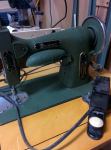
Basil, the White 77 (rotary): Basil was another garage sale find. He is strong and doesn’t shy away from projects that have thick layers of fabric. He was branded by the Eaton’s department store with the Viking name. He has a complete compliment of rotary style attachments – from blind hemmers to binders to ruffle and shearing attachments. Basil’s exact year of creation is still a mystery. He is currently experiencing a few tension issues, but I’m learning how to help him become a functional and productive member of my sewing family. His electrics and hardware are in great condition.
- April 2017: This machine was donated to our local thrift store.
 Rosemary, the 1948 Singer 15-89 treadle: Rosemary is in perfect condition. She features a beautiful and consistent stitch and is euipped with reverse for back tacking. She has a complete compliment of attachments, including Singer’s buttonhole attachment. Singer’s button holer creates the perfect key-hole style buttonholes each and every time. Rosemary belonged to my husband’s grandmother and helped his mother learn to stitch. She lives in a beautiful five drawer solid wood cabinet.
Rosemary, the 1948 Singer 15-89 treadle: Rosemary is in perfect condition. She features a beautiful and consistent stitch and is euipped with reverse for back tacking. She has a complete compliment of attachments, including Singer’s buttonhole attachment. Singer’s button holer creates the perfect key-hole style buttonholes each and every time. Rosemary belonged to my husband’s grandmother and helped his mother learn to stitch. She lives in a beautiful five drawer solid wood cabinet.
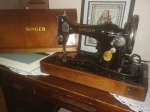 Thyme, the 1936 Singer 128: Most of my machines are stationary. When I discovered the need to be more mobile, I began a search for a vintage travel machine. My search began with Thyme (and still going!). She is operated by a knee drive and housed in a lovely, nearly perfect, bent wood case. Her value is beyond measure. Even though she lacks reverse, she is quiet and powerful. Thyme uses a vibrating shuttle bobbin mechanism that, in my opinion, provides a better tension than other types of bobbin mechanisms.
Thyme, the 1936 Singer 128: Most of my machines are stationary. When I discovered the need to be more mobile, I began a search for a vintage travel machine. My search began with Thyme (and still going!). She is operated by a knee drive and housed in a lovely, nearly perfect, bent wood case. Her value is beyond measure. Even though she lacks reverse, she is quiet and powerful. Thyme uses a vibrating shuttle bobbin mechanism that, in my opinion, provides a better tension than other types of bobbin mechanisms.
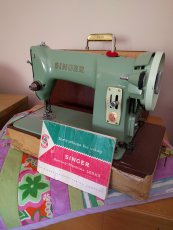
Sage, the Singer 185K-3 (1960): Sage was known as Singer’s little green machine. These machines were produced between 1958 and 1964. Don’t let her size and cuteness fool you, though. She is very powerful and stitches through almost anything a stitcher can throw at her. She features reverse and a horizontal oscillating hook drop-in style bobbin. The 185K was Singer’s answer to updating the popular 99K. She is heavy but a very fast stitcher. My daughter loves this machine and has claimed ownership of her. (The K notes that the machine was manufactured in the United Kingdom plant.)
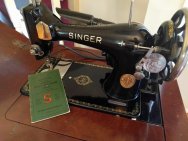 Liz Tailor, the Singer 128-13: Liz is the most glamourous member of my sewing family. She has been well maintained over the years and simply sparkles. This electric sewing machine, manufactured in St. John’s, Quebec, between 1945 and 1948, features the vibrating shuttle bobbin mechanism. Liz’s cabinet shines as brightly as her metallic black finish. It has inlaid parquet work that makes her even more of a star on any stage.
Liz Tailor, the Singer 128-13: Liz is the most glamourous member of my sewing family. She has been well maintained over the years and simply sparkles. This electric sewing machine, manufactured in St. John’s, Quebec, between 1945 and 1948, features the vibrating shuttle bobbin mechanism. Liz’s cabinet shines as brightly as her metallic black finish. It has inlaid parquet work that makes her even more of a star on any stage.
 Ginger, the Singer 191B: Ginger is a lovely light beige (with a pink undertone) machine that I rescued from a local thrift store. She is in a beautiful solid wood cabinet that has a bench with a removable seat lid that allows for storage. She came with a full compliment of attachments and features both reverse and and the ability to drop her feed dogs by turning a dial. Ginger has the perfect straight stitch, is easy to use, and compliments any decor.
Ginger, the Singer 191B: Ginger is a lovely light beige (with a pink undertone) machine that I rescued from a local thrift store. She is in a beautiful solid wood cabinet that has a bench with a removable seat lid that allows for storage. She came with a full compliment of attachments and features both reverse and and the ability to drop her feed dogs by turning a dial. Ginger has the perfect straight stitch, is easy to use, and compliments any decor.

Agave, the Singer 328 Stylemate (1968): Agave is a beautiful machine that allows for a bit more creativity. His stitches are straight and even, but it is the fashion discs that appeal to me. Nine discs allow Agave to perform a range of stitches from zigzags and satin stitches to more decorative accent stitches. He is a decorative demon that adds beauty and fun to most projects. Agave needs a new cabinet, but otherwise works to perfection.
- As of July 2015, Agave lives with a good friend. Since Cinnamon, 1958 Singer 401a, came to live with me, he is no longer needed. Rest assured that his seamstress will love and care for him as I have. I will pop in on him now and again to make sure he is oiled and running well.
- Agave’s baby brother came to live with us during September 2015. His motor is strong and healthy, but he is missing a few parts. My husband and I plan to bring him to life again.
Agave, the Singer 328 Stylemate (1968): Agave is a beautiful machine that allows for a bit more creativity. His stitches are straight and even, but it is the fashion discs that appeal to me. Nine discs allow Agave to perform a range of stitches from zigzags and satin stitches to more decorative accent stitches. He is a decorative demon that adds beauty and fun to most projects. Agave needs a new cabinet, but otherwise works to perfection.
 Cinnamon, the 1958 Singer 401a: She is a strong stitcher with the ability to get a little fancy. She uses top hat cams to accomplish some of stitches (I hope to collect all available cams for her), but most of the fancy stitches, zig zags, and scallops are accomplished by adjusting the two stitch dials on the front. She does a great satin stitch that allows me to experiment with a bit of machine embroidery and custom embellishments, like monogramming. Cinnamon is a slant machine, which means that there is more of the needle exposed.
Cinnamon, the 1958 Singer 401a: She is a strong stitcher with the ability to get a little fancy. She uses top hat cams to accomplish some of stitches (I hope to collect all available cams for her), but most of the fancy stitches, zig zags, and scallops are accomplished by adjusting the two stitch dials on the front. She does a great satin stitch that allows me to experiment with a bit of machine embroidery and custom embellishments, like monogramming. Cinnamon is a slant machine, which means that there is more of the needle exposed.
My husband and I rescued this 1922 Singer 127 treadle from my his aunt, who was going to abandon her at the dump. Yes, there are people in this world that abandon these beauties to the elements. They are unloved. They are many. Hibiscus now lives in my dining room and is the first machine that greets visitors as they enter my home. She is embellished with nearly perfect Sphinx decals that shine in the morning sun. She has a bit of “pin rash” around her neck where former seamstresses would attach a piece of cloth to hold pins. I am in the process of cleaning her up, but she works well. She has a vibrating shuttle bobbin mechanism and doesn’t skip a stitch.
rescued this 1922 Singer 127 treadle from my his aunt, who was going to abandon her at the dump. Yes, there are people in this world that abandon these beauties to the elements. They are unloved. They are many. Hibiscus now lives in my dining room and is the first machine that greets visitors as they enter my home. She is embellished with nearly perfect Sphinx decals that shine in the morning sun. She has a bit of “pin rash” around her neck where former seamstresses would attach a piece of cloth to hold pins. I am in the process of cleaning her up, but she works well. She has a vibrating shuttle bobbin mechanism and doesn’t skip a stitch.
 My husband gifted me this 1948 Singer 201K-3, Lavender, in December 2015. It is becoming more and more difficult for me to sew on a treadle machine or use a foot pedal due to the lack of feeling in my feet (or too much feeling that is very painful). I suffer from Osteoarthritis and Diabetes 2, which makes things a bit difficult for me. I began searching high and low for machines that were in cabinets operated by the knee instead of the more common foot pedal on the floor. Lavender has given me my stitching life back. As long as I remember to move regularly, I can sit and stitch once again. Lavender also has a full compliment of accessories, including:
My husband gifted me this 1948 Singer 201K-3, Lavender, in December 2015. It is becoming more and more difficult for me to sew on a treadle machine or use a foot pedal due to the lack of feeling in my feet (or too much feeling that is very painful). I suffer from Osteoarthritis and Diabetes 2, which makes things a bit difficult for me. I began searching high and low for machines that were in cabinets operated by the knee instead of the more common foot pedal on the floor. Lavender has given me my stitching life back. As long as I remember to move regularly, I can sit and stitch once again. Lavender also has a full compliment of accessories, including:
- Button hole attachment
- ZigZag attachment
- Ruffler
- Foot and Adjustable Hemmers
- Binder
- Tucker
Lavender is now my main machine. From denim to cotton to chiffon, Lavender delivers the perfect stitch each and every time. The feature I’m most looking forward to trying out is her feed dog drop. I’m working on a lap quilt that was pieced on and will be quilted on Lavender.
 My husband is no longer immune to the vintage sewing machine (VSM) lifestyle. He found Rose in January 2016. She is a centennial edition Singer 15-90 in a bent wood case. Rose has seen a lot of stitching throughout her lifetime and needed a lot of tender loving care. My husband was able to remove most of the dings from her base and is currently working on the dome. She will need a new electric cord, as hers is cracked and taped and dry.
My husband is no longer immune to the vintage sewing machine (VSM) lifestyle. He found Rose in January 2016. She is a centennial edition Singer 15-90 in a bent wood case. Rose has seen a lot of stitching throughout her lifetime and needed a lot of tender loving care. My husband was able to remove most of the dings from her base and is currently working on the dome. She will need a new electric cord, as hers is cracked and taped and dry.
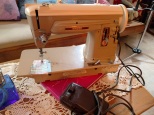
Meet Cinnamon’s (the Singer 401a above) brother, Dandy (short for Dandelion). He is a Singer 404, the base model of Singer’s slant machine series. Dandy is an extra durable, sturdy, powerful machine with a drop in bobbin. He makes a most perfect straight stitch and will take on any of Singer’s slant attachments. He works well on his own or in a cabinet. He is not as portable as the 301 or a Featherweight, but he will work steady and true (he is very very heavy).
- Dandy is moving in with my sister. I gifted her this machine to my sister for her birthday in 2016. It is her first slant machine.
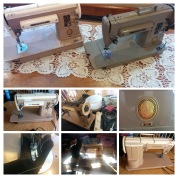 The Twins are a pair of Singer 301s from the mid 1950s. They are lightweight (very portable), quiet, and fast. They are a bit more sturdy than the Singer Featherweights, but stitch just as well. These are slant machines and will handle the attachments for Singer’s slant series. I’m not sure you actually get a better view of the needle or your work, but they are beautiful machines to use.
The Twins are a pair of Singer 301s from the mid 1950s. They are lightweight (very portable), quiet, and fast. They are a bit more sturdy than the Singer Featherweights, but stitch just as well. These are slant machines and will handle the attachments for Singer’s slant series. I’m not sure you actually get a better view of the needle or your work, but they are beautiful machines to use.
Some consider the 301 the big brother to the the Featherweight, but this is a myth. The 301 and the Featherweights share the same bobbin case and both are cast from aluminum, which makes them light and portable. But that is where the similarities end. The 301
Many people call the 301 the big sister to the featherweight but that is incorrect.
They share the same bobbin case and both are cast from aluminum. Other than that they are different class machines. The 301 will produce 1,500 spm. It works as a table top machine or is easily mounted in your favourite cabinet. So, rather than the big sister, I think the 301 is more of a favourite cousin to the Featherweight.
 Every so often the stars align and the fates smile upon us mere mortals. Today (June 16, 2016) is one of those days! The sewing goddess directed me to this beautiful 1955 Singer Featherweight 221K. Her name is Daisy.
Every so often the stars align and the fates smile upon us mere mortals. Today (June 16, 2016) is one of those days! The sewing goddess directed me to this beautiful 1955 Singer Featherweight 221K. Her name is Daisy.
I’ve been waiting a very long time for a Featherweight to find me. They are light, quiet, and sew a good quality stitch. She came with a complete set of attachments and a button hole attachment . (As an added bonus, I found a set of white cams in the case that will work with my Singer Automatic ZigZagger!) Daisy’s case is a little beat up here and there, but it adds character to her.
Daisy’s previous owner bought her brand new 55 years (just before she married and started a family in Weyburn, Saskatchewan). She found that sewing was not her thing. She was more of a knitter/crocheter and decided it was time to part ways with Daisy. Daisy was fully serviced in 2009 and hasn’t been used since.
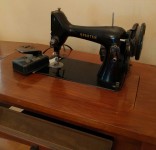
The Singer Spartan 192 was Singer’s economy sewing machine. It is a bare bones straight stitch machine with reverse. Spartans were born of a need for Singer to compete with cheaper, less expensive imports. The Spartan is really a stripped down 99. There is no light (and nowhere to mount a light on this one), and no decals. It is a 3/4 sized machine. This machine has been well loved over its life time. It needs a deep cleaning, new electrical cord, a bit of repair to the bobbin cover, and the cabinet needs refinishing.
This is the before picture. I hope to begin the restoration process
soon. I found this little cutie in July 2016.- April 2017: This machine was donated to our local thrift store.
 I’ve wanted to include a Singer 500a (name is forthcoming) in my collection since I fist set eyes on them. I was lucky enough to find one at good price in August 2016. The 500a, in my opinion, really lives up to Singer’s pledge that “What’s new for tomorrow is at Singer today!” The 500a is an updated version of Singer’s 401a. Singer made a few cosmetic changes, enclosed the thread spool pins inside the lid, and moved the bobbin winder. Otherwise, the machines are the same. The 500a is known as the Rocketeer due to its futuristic styling. It reminds me of something that Mrs. Jetson would use!
I’ve wanted to include a Singer 500a (name is forthcoming) in my collection since I fist set eyes on them. I was lucky enough to find one at good price in August 2016. The 500a, in my opinion, really lives up to Singer’s pledge that “What’s new for tomorrow is at Singer today!” The 500a is an updated version of Singer’s 401a. Singer made a few cosmetic changes, enclosed the thread spool pins inside the lid, and moved the bobbin winder. Otherwise, the machines are the same. The 500a is known as the Rocketeer due to its futuristic styling. It reminds me of something that Mrs. Jetson would use!
 This Singer 774 (came along with the 500a above – August 2016). It sews well and is the most modern of my machines. It is simple enough to handle any beginner sewer’s learning curve and has enough features to serve the most advanced sewer’s needs. For the most part, I leave my Singer monogrammer connected to this machine. On the rare occasion that I need to use a free arm, this is the machine that accomodates need. All of her accessories and the original manual are with this machine.
This Singer 774 (came along with the 500a above – August 2016). It sews well and is the most modern of my machines. It is simple enough to handle any beginner sewer’s learning curve and has enough features to serve the most advanced sewer’s needs. For the most part, I leave my Singer monogrammer connected to this machine. On the rare occasion that I need to use a free arm, this is the machine that accomodates need. All of her accessories and the original manual are with this machine.
Singer produced these machines in the 1970s. It has plastic gears, drop-in bobbin, adjustable stitch lenght and width, and an adjustable needle position. It accomodates twin needle stitching. It has a suite of basic specialty stitches and will stitch a decent button hole. This machine will stitch through delicate fabric and accomodate some heavier weight fabrics.
 This Singer Style-o-Matic, model 328 (became part of my sewing family in March of 2017), was born in 1961. It came complete with all its attachments and fashion discs, which produce a variety of decorative stitch patterns. It has a complete set of attachments common to Singer machines at the time. It also has its original manual. The machine can be used on a table top and has a protective case that covers the machine. It also fits into a blonde desk.
This Singer Style-o-Matic, model 328 (became part of my sewing family in March of 2017), was born in 1961. It came complete with all its attachments and fashion discs, which produce a variety of decorative stitch patterns. It has a complete set of attachments common to Singer machines at the time. It also has its original manual. The machine can be used on a table top and has a protective case that covers the machine. It also fits into a blonde desk.
One of my best friends saw this machine with a “free to a good home” sign on it across the street from him. He quickly stowed the machine away in his garage where it awaited pick up. It needs a little love and a good cleaning, but will be stitching along soon.
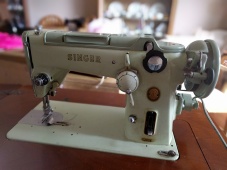 This Singer 319 was born in 1957 and became part of my sewing family in April 2017. I do not know a whole lot about this vintage beauty, but will update this page as I learn more. It came along with all its attachements and a full set of stich discs. It was well maintained by its previous owner, but will need a good cleaning along with a bit of grease.
This Singer 319 was born in 1957 and became part of my sewing family in April 2017. I do not know a whole lot about this vintage beauty, but will update this page as I learn more. It came along with all its attachements and a full set of stich discs. It was well maintained by its previous owner, but will need a good cleaning along with a bit of grease.
I’ve had the 319 on my wish list because of its unique styling and ability to stitch a variety of stitches. Its “piano key” type stitch control, combined with the stitch discs, are capable of producing hundreds of decorative and functional stitches. This machine uses a 20U bobbin and a Type 206 x 13 needles, which has a shorter point than the classic 15 x 21 needle. Using the wrong needle type could spell disaster for the bobbin case. This machine came with two needle cases and, I hope, is capable of using both needle types. A little experimentation is warranted.
#Racist, #colonialist #SaskParty dog-whistling
I made my calls. Will you make yours?
These folks are not disturbing the peace nor are they violent. When will this government talk to these folks rather than engage in costly and ineffective court cases.
The campers have my support. The Saskatchewan Party does not.
The Regina Mom has been writing, but not blog posts until today, when she read the CBC News story about Premier Moe’s latest racist action.
The province is taking legal action against members of the camp and Regina Police Chief Evan Bray, according to court documents that were filed Tuesday at Regina’s Court of Queen’s Bench.
said Chevy, the Minister Responsible for the Provincial Capital Commission, in the prepared statement. He added that he’s doing this because
The Wascana Park bylaws prohibit unauthorized overnight camping, erecting and maintaining structures, and burning combustibles, and we are asking that these bylaws be enforced,”
The Regina Mom is pretty sure this is a dogwhistle for the racist core in the Sask Party. We are heading into an election in the next couple of years and Moe will want to shore up that support.
In response, the Regina Mom made some phone calls a…
View original post 127 more words
Good Story and Good food
 Food, Health and Happiness: 115 On-Point Recipes for Great Meals and a Better Life by Oprah Winfrey
Food, Health and Happiness: 115 On-Point Recipes for Great Meals and a Better Life by Oprah Winfrey
My rating: 4 of 5 stars
I’ve loved all things Oprah for what seams like my entire life. Oprah introduced me to new gadgets, new ways of living, and helped me see a better way of being. This book is a continuation of that learning.
This book is a memoir and a cook book. I mostly bought it for the memoir, but was pleasantly surprised with the recipes. Whether you are counting points with Weight Watchers or looking to eat better, the recipes in this book will not disappoint. Oprah’s taste for spice is a bit higher than my own, but I can work with the variety of recipes in this book. I love that she has included some of her favourite kitchen gadgets and tells us why she loves them. I am looking forward to trying out some of the recipes in this book.
Whether you are interested in knowing more about Oprah’s life and struggle with food or looking for a Weight Watcher’s friendly dietary make over, this book is well worth having.
Portable Stitching: a dream come true
My featherweight dreams came true on June 16, 2016. I finally found the machine of my dreams. Meet Daisy, a 1955 Singer 221K Featherweight sewing machine. She has a few nicks here and a couple pin scratches there. She runs beautifully. She has a full compliment of feet and a button hole attachment. Daisy is a dream come true!
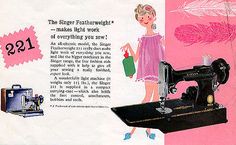 I’ve wanted to include a Featherweight in my sewing family for a long time. Featherweights may be tiny when compared to their big brothers and sisters, but they are mighty. These machines were intended to be used in a family setting just like their full sized brothers and sisters. They helped a household make ends meet by bringing in a little extra income. They stitched many a costume and fancy dress. They mended curtains, denims, canvas, and all sorts of cloth items both in and out of the house. They carry memories from the past to the present as they are handed down from one generation to the next. Even though a Singer Featherweight 221K may have a nick here and a pin scratch there, they continue to stitch better than modern machines. Their tiny blemishes show just how well loved the machine was. They are marks of wisdom that add character to a fine piece of machinery. (Check out this wonderful story of Adele, a very Featherweight (posted on the Singer Featherweight Shop’s blog)).
I’ve wanted to include a Featherweight in my sewing family for a long time. Featherweights may be tiny when compared to their big brothers and sisters, but they are mighty. These machines were intended to be used in a family setting just like their full sized brothers and sisters. They helped a household make ends meet by bringing in a little extra income. They stitched many a costume and fancy dress. They mended curtains, denims, canvas, and all sorts of cloth items both in and out of the house. They carry memories from the past to the present as they are handed down from one generation to the next. Even though a Singer Featherweight 221K may have a nick here and a pin scratch there, they continue to stitch better than modern machines. Their tiny blemishes show just how well loved the machine was. They are marks of wisdom that add character to a fine piece of machinery. (Check out this wonderful story of Adele, a very Featherweight (posted on the Singer Featherweight Shop’s blog)).
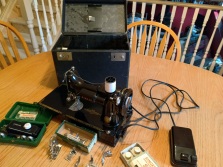
Daisy, 1955 Singer Featherweight 221K
Since Osteoarthritis ran rampant throughout my spine, I’ve been limited in the amount I can lift and carry. This meant that I was not able to take my stitching on the road as most of my machines weigh at least twice (sometimes three times) the weight that I am allowed to manage. There are a few soulless plastic machines on the market that I might be able to lift and carry, but they lack the character and quality of my vintage machines. I needed to find myself a highly coveted Singer Featherweight machine.
I began my search and quickly realised that portability and quality have a hefty price tag attached to them. Featherweights were scarce and the ones that were available were beyond my meagre budget. I put my dream of ownership on the back shelf and continued to collect Singer sewing machines, none of which were all that portable. You can meet my sewing family here. I knew that the right machine for the right price would cross my path eventually.

Daisy, 1955 Singer Featherweight 221K
Fast forward to June 16, 2016. I happened to be checking Kijiji.ca while sipping on my morning cuppa. The first advert I came across was for Daisy. Her owner didn’t like to sew much and wanted to find Daisy a home where she would be used and well loved. After a few messages and a phone call with Daisy’s owner, I made the trip across the city to pick her up. Daisy was mine! I was the proud caretaker of a 1955 Singer Featherweight! The sewing goddess finally wrangled the fates into line and allowed all the energies to work together to help bring Daisy home to me.
Sew, with a little patience and a lot of luck, I am a portable stitcher again. I look forward to carrying Daisy to stitching classes. I look forward to visiting my sister with Daisy in tow to stitch and laugh. I look forward to meeting clients in their home to mend their treasures or teach them the finer art of stitching. I look forward to learning new tricks of the trade while remembering stitchers past who sat in front of this very machine while creating beautiful masterpieces to beautify their homes and clothe their children. I look forward to many more years with Daisy.

Daisy, 1955 Singer Featherweight 221K, loves to piece quilt blocks.
PS: The “K” in 221K means that Daisy was created at the Scotland Singer Factory. This is my second machine from Great Britain. Knowing that this machine was made in Scotland adds a touch of extra special magic.
What do you sew with?
Stitching each SEWin’ Day to its fullest!
The perfect combination!
 What happens when you combine volunteerism, friendship, and a love of vintage sewing machines with a whole lot of stitching? You have the perfect recipe for satisfaction and fun! This is exactly how our guest poster, Catherine R. Voegtlin, lives her life. She is a long-time stitcher and quilter who loves to bring other stitchers together to create quilts for charity. She invites other volunteers to join her in stitching charity quilts with her growing collection of vintage sewing machines. This creates a wonderful quilting experience that appeals to stitchers of all skill levels.
What happens when you combine volunteerism, friendship, and a love of vintage sewing machines with a whole lot of stitching? You have the perfect recipe for satisfaction and fun! This is exactly how our guest poster, Catherine R. Voegtlin, lives her life. She is a long-time stitcher and quilter who loves to bring other stitchers together to create quilts for charity. She invites other volunteers to join her in stitching charity quilts with her growing collection of vintage sewing machines. This creates a wonderful quilting experience that appeals to stitchers of all skill levels.
I’ve known Catherine on Facebook for a short while and her love of vintage sewing machines, her quilting talents, her giving nature, and her kindness inspire me each and every time we connect in the Vintage Sewing Machine Facebook group. I am grateful I’ve come to know Catherine and am privileged call her friend. It is my honour to introduce her to you. She is truly inspirational!
This is her story…
Who is Catherine R. Voegtlin?
 Catherine fell in love with stitching 47 years ago. She started quilting in the mid 1980s and participated in her first quilting retreat in 2010: She “…stood in that room and was transfixed by the sight and sounds of women doing the same thing [she] loves to do – quilting.” Catherine found per people and never wanted to leave. She calls many quilters and seamstresses friend and invites them into her home for SEWin’ Days.
Catherine fell in love with stitching 47 years ago. She started quilting in the mid 1980s and participated in her first quilting retreat in 2010: She “…stood in that room and was transfixed by the sight and sounds of women doing the same thing [she] loves to do – quilting.” Catherine found per people and never wanted to leave. She calls many quilters and seamstresses friend and invites them into her home for SEWin’ Days.
Stitching each SEWin’ Day to its fullest!
I belong to a small church congregation and its Hope Fellowship Ladies Bible Study Group. We have prayed and explored our faith together for more than a dozen years. The bible study group members are my friends. We know each others’ tastes. We share each others’ passions.
Quilting is one of those passions. Faith is another. I’ve been known to bring a quilt to a meeting. My friends appreciate the effort involved in creating a quilt, but most of them are not sewing maniacs. I confess that I may be a sewing maniac and I embrace it!
Hearts filled with the giving spirit
My group of friends and I welcome new members. My friend, Laura, welcomed me and together we welcomed Maggie Hubbard to our group. Both ladies sewed and their hearts were filled with giving spirits.
Maggie volunteered in a big way with the Olive Tree Children’s Ministry Oregon, headed by Pastor Francisco Camacho. Maggie joined as many volunteers as she could muster, including doctors, dentists and carpenters, on a yearly trek to Mexico. Maggie filled her motor home with medicines, quilts, food, and crocheted hats, which she drove from Portland, Oregon, to Ensenada, Mexico, each year. Our congregation prayed that Maggie and this team of volunteers made it across the border with as little trouble as possible.
SEWin’ Days
The more we prayed and thought about Maggie’s kind heart and her mission, the more we wanted to put our own quilting and stitching skills to work to help with her ministry. I was thrilled when Maggie and Laura organized several SEWin’ Days where stitchers brought their own machines to church. We stitched together and we created items to add to Maggie’s inventory. Everyone wanted to contribute. Some stitched quilt blocks, some quilted them, and others tied quilts. We all worked to create items filled with love that we hoped would provide comfort to people in need.
A Quilters’ Love
Laura started to love quilting. I loved that I had two new stitching friends that enjoyed stitching as much as I did. I had sewing buddies! We worked together to produce quilted items filled with love. We wondered how we could share the joy of stitching, the thrill of quilting, and the beauty of friendships that develops over stitches.
We “hounded” the ladies in our small, loving congregation to join the fun. We tried meeting right after the close of our regular bible study meetings. We invited ladies to join us, but very few did. We tried setting up SEWin’ Day sessions at our church. Our fellow congregates weren’t fooled. We ended up sewing by ourselves with the occasional interested soul stopping in to help tie a quilt. This didn’t dampen our spirits. We knew that a quilters’ love always finds a way!
SEWin’ Heartbreak
Maggie, Laura, and I had hopes and dreams for our congregation. We prayed that our love of stitching was infectious and more ladies would join us for SEWin’ Days. We were getting more than 30 quilts ready for Maggie’s next trip to Mexico. We were up for sewing with anyone anywhere. We even sewed with residents and campers at one of Maggie’s favourite RV parks. We needed stitcherly help to finish off those 30 quilts.
Maggie became ill during this SEWin’ weekend and she passed away the following week. She left a very big void in the lives of everyone she touched. Laura and I pledged to continue Maggie’s good works in whatever small way we could.
The Stash
 Quilters love fabric. We collect it. We care for it. We keep a lot of it on hand. Each piece of fabric in a quilter’s stash is meaningful. A quilter’s stash is like a carefully curated library, where a librarian lovingly selects volumes to fill out her shelves. The quilter selects each piece of stash fabric carefully and deliberately. It joins other fabrics on a her shelves. The quilter is a committed stitcher and will eventually bring each piece together to form patterns that both entice and delight – no matter how long a piece spends in the stash. The stash is one with the quilter and tells her story.
Quilters love fabric. We collect it. We care for it. We keep a lot of it on hand. Each piece of fabric in a quilter’s stash is meaningful. A quilter’s stash is like a carefully curated library, where a librarian lovingly selects volumes to fill out her shelves. The quilter selects each piece of stash fabric carefully and deliberately. It joins other fabrics on a her shelves. The quilter is a committed stitcher and will eventually bring each piece together to form patterns that both entice and delight – no matter how long a piece spends in the stash. The stash is one with the quilter and tells her story.
Quilters are as careful and deliberate as librarians when it comes to curating the perfect collection of texture and colour. The quilter uses her stash, just as the librarian uses her books, to tell a larger story. Each piece of fabric works in harmony with each other just as each book in a librarian’s collection works to provide a broad selection of knowledge.
Maggie’s Legacy – The Stash
Laura and I were invited to care for some of Maggie’s large fabric stash. We washed, sorted, and folded fabric. We organized the stash into a coherent library of colour and texture, which was carefully placed on shelves at our local church. Our fellow congregants began to appreciate this wall of coloured inspiration. Just as Maggie inspired the many lives she touched, this wall of colour is now inspiring the creative spirits of my fellow congregates.
As we admired our work, we wondered where our sewing journey would take us next. We were now in the driver’s seat and Maggie is our passenger. How would we carry on and do her memory the justice it deserves? What would we sew next? Who would we sew for?
Enter Vintage Sewing Machines
 While pondering these questions, I had been bitten by the vintage sewing machine (VSM) bug. I had been acquiring VSMs – one here, two there – you know how it goes. My 14 VSMs live well with my husband and I and my three modern machines. I tinker with them. I enjoy them. VSMs give me a thrill when I restore them to working order. Although people often stare at me when I reveal that I live with 14 VSMs, other quilters and stitchers completely understand their powerful draw.
While pondering these questions, I had been bitten by the vintage sewing machine (VSM) bug. I had been acquiring VSMs – one here, two there – you know how it goes. My 14 VSMs live well with my husband and I and my three modern machines. I tinker with them. I enjoy them. VSMs give me a thrill when I restore them to working order. Although people often stare at me when I reveal that I live with 14 VSMs, other quilters and stitchers completely understand their powerful draw.
 I am not as much of a VSM purist as others are, but I fully enjoy their beauty and sense their magical essence whenever I sit in front of a VSM. These old machines carry history and stories. I can’t help but hear the whispers of the past or imagine a stitcher of long ago mending or dressmaking on these lovely machines. The more time Laura and I spent together, the more she began to love VSMs too. Their magic was working on her with each and every stitch. We formed the perfect stitcherly collaboration of history, love, friendship, and joy. We wanted to share it.
I am not as much of a VSM purist as others are, but I fully enjoy their beauty and sense their magical essence whenever I sit in front of a VSM. These old machines carry history and stories. I can’t help but hear the whispers of the past or imagine a stitcher of long ago mending or dressmaking on these lovely machines. The more time Laura and I spent together, the more she began to love VSMs too. Their magic was working on her with each and every stitch. We formed the perfect stitcherly collaboration of history, love, friendship, and joy. We wanted to share it.
We decided to include my VSM collection in our efforts to honour Maggie’s life and work.
Maggie’s spirit lives on
We continued to think about Maggie, her stash, and how we could transform that stash into a legacy that was worthy of representing Maggie’s life’s work. Laura suggested that we begin to sew for a local ministry, the Hope 360* Pregnancy Care Centre (directed by Joanne Eggimann). They needed baby quilts. We found our project! We began to get excited about the possibility of giving Maggie’s spirit new life.
This might provide the octogenarians and other members of our church the inspiration they needed to embrace the love of sewing. Who doesn’t love babies? Who could refuse the chance to wrap a baby in love? But, we knew, no one wanted to drag their sewing machine around to accomplish the work. We had to make it easy, enticing, and convenient for these novice stitchers to participate.
SEWin’ Days – take two!
 The answer was staring me in the face. I had at least 14 machines that needed love. They wanted to be used! I had a husband who loved to cook. He wanted to entertain. I had the room to accommodate the stitching process, from stitching and pressing to connecting quilt blocks into a baby quilt. I wanted to share my joy, my love, and my knowledge with anyone who wanted to stitch. Sew…
The answer was staring me in the face. I had at least 14 machines that needed love. They wanted to be used! I had a husband who loved to cook. He wanted to entertain. I had the room to accommodate the stitching process, from stitching and pressing to connecting quilt blocks into a baby quilt. I wanted to share my joy, my love, and my knowledge with anyone who wanted to stitch. Sew…
 My first SEWin’ Day was born! I started to think about the fact that I now had more machines than ladies in my bible study group. I set the machines up and asked my husband to create something delicious to feed 15 hungry stitchers. I prepped and cut and stitched. I wanted to eliminate any frustration in the stitching process and create an enjoyable experience that people loved.
My first SEWin’ Day was born! I started to think about the fact that I now had more machines than ladies in my bible study group. I set the machines up and asked my husband to create something delicious to feed 15 hungry stitchers. I prepped and cut and stitched. I wanted to eliminate any frustration in the stitching process and create an enjoyable experience that people loved.
Simplicity is the key to success!
 Making the quilting process easy and frustration free was key to spreading my passion. I cut all the fabric strips. I started the blocks and kept them simple. Stitchers needed to stitch in straight lines only. Vintage sewing machines, ready to stitch, occupied my dining room. This included two Singer Featherweights, a Singer 128, two Singer 401s, a Singer 403, two Singer Rocketeers, a Kenmore 148, and two treadles (Singer 15-88 and a Singer class 66). A table covered with brightly coloured fabric strips ready to be stitched greeted stitchers as they walked in. There was a cutting table and pressing stations. It was the perfect setup for stitchers to stitch and get to know one another while enjoying the magic of vintage machines.
Making the quilting process easy and frustration free was key to spreading my passion. I cut all the fabric strips. I started the blocks and kept them simple. Stitchers needed to stitch in straight lines only. Vintage sewing machines, ready to stitch, occupied my dining room. This included two Singer Featherweights, a Singer 128, two Singer 401s, a Singer 403, two Singer Rocketeers, a Kenmore 148, and two treadles (Singer 15-88 and a Singer class 66). A table covered with brightly coloured fabric strips ready to be stitched greeted stitchers as they walked in. There was a cutting table and pressing stations. It was the perfect setup for stitchers to stitch and get to know one another while enjoying the magic of vintage machines.
I got the word out to my friends and my bible study group. The women came ready to stitch. They loved the experience and are anxious to do it again. These ladies filled my house and heart with love and friendship, which we translated into enough blocks to create two baby quilts.
More SEWin’ Days to come…
 We will be doing this again! My lovely VSMs got a work out, which is very good for them. My friends got to experience the joy that comes with stitching on a VSM. Some of my friends came to quilt and are now hooked on quilting. Others came to visit and be a part of something greater. We all agreed that being with each other was the best part.
We will be doing this again! My lovely VSMs got a work out, which is very good for them. My friends got to experience the joy that comes with stitching on a VSM. Some of my friends came to quilt and are now hooked on quilting. Others came to visit and be a part of something greater. We all agreed that being with each other was the best part.
The delicious lunch, the VSMs, and the easy drop-in-and-sew format of this SEWin’ Day pleased everyone. I will do it again and next time I’m going to leave it up for three days and have drop in hours for each day. We worked with Maggie’s fabrics to create baby quilts for the Hope 360* Pregnancy Care Centre. We plan to continue to play together, pray together, eat together, and sew together.
Hooray! You read the whole post! Wanna hang out more? Check out the best stitching pins with me on Pinterest, join our lively Facebook discussions, enjoy some stitcherly eye candy on Instagram, connect with me on Twitter, and stay up-to-date on all things stitching through our newsletter.
What’s in your stash?
Buying Handmade
A little vintage goes a long way!
 I’ve written about the Bionic Gear Bag (BGB) pattern by Sally Thompson before. It is a transformative pattern that will teach beginners the basics of sewing. It is challenging enough to keep the more experienced among us interested through to the last stitch. The resulting bag will transform the way you organize your essentials. It also serves as an important test project for my vintage sewing machines.
I’ve written about the Bionic Gear Bag (BGB) pattern by Sally Thompson before. It is a transformative pattern that will teach beginners the basics of sewing. It is challenging enough to keep the more experienced among us interested through to the last stitch. The resulting bag will transform the way you organize your essentials. It also serves as an important test project for my vintage sewing machines.
I have a BGB for my makeup and toiletries. I have one for my sewing tools and notions. I have made BGBs for gifts. I plan to make more to house my electronics’ cords, chargers, and other bits and bobs. I would like to fill one with office supplies to add to my mobile office set up. I will stitch one to help keep my knitting notions organized and accessible. The BGB is versatile and perfectly sized to easy to grab and go no matter what you fill it with.
The BGB is my go-to pattern when I add a new vintage sewing machine to my family (meet my sewing family here). Once a new machine is cleaned, serviced and polished, I use it to stitch a BGB.
- The BGB creation process puts each machine through a rigorous process that shows me what the machine is capable of.
- There are lots of bumps and bulk to test the machine’s ability to sew through layers.
- The installation of five zippers helps me determine tension and stitch quality.
- The BGB helps me decide if the machine will stay or go and whether that machine is in need further need of more servicing by someone more experienced than I.
My most recent machine is a 1956 Singer 401a, Cinnamon. She made it through the BGB without a skipped stitch or broken needle. This is a very powerful machine with lots of fancy stitch options. She sews a quality stitch that is straight and true. Cinnamon is now my “forever” machine. She passed this important test with flying colours!
- Find out more about the Bionic Gear Bag
- Sign up for a class with me and create your very own Bionic Gear Bag (both virtual and in-person options are available)
The BGB featured in the photo is for sale in my Etsy shop.(This item has sold.)
Place your order for a customised Bionic Gear Bag today!
What are you sewing on?




